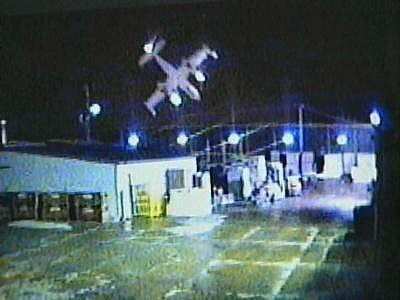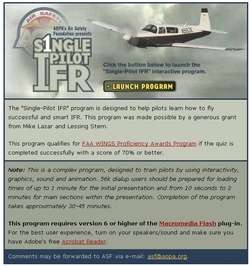This... Not User Fees... Is The Single Most Important Issue
Facing ALL Pilots
By nearly accounts, 2006 will go down as a banner year for
general aviation. Sales of GA planes remain healthy, with a varied
selection of capable aircraft. You likely won't find many new plane
owners complaining they couldn't find just what they were looking
for. (Whether it was available at the price they were looking for,
though, is a different matter.)

Furthermore, the wide selection of new planes available also
serves to drive down prices on existing airframes. Whereas news
planes can still be considered a seller's market... if a buyer is
considering a used plane, they would seem to have the upper
hand.
Even in the face of ever-climbing fuel prices, buyers don't seem
to be put off too much by sticker shock, if GAMA's year-to-date
numbers for 2006 are an indication. People are buying, planes have
little chance to collect dust on dealer lots... manufacturers are
happy.
 Not all is well,
though. Several issues that could tank -- I'll say it again, TANK
-- the latest GA boom are just over the horizon. Most visible is
the impending FAA funding battle... but there are very real
concerns also about attracting new pilots to the fold, and insuring
they are properly trained. As the baby boomer generation has aged,
so has the pilot community... and we're not bringing in new bodies
anywhere quickly enough. Yet.
Not all is well,
though. Several issues that could tank -- I'll say it again, TANK
-- the latest GA boom are just over the horizon. Most visible is
the impending FAA funding battle... but there are very real
concerns also about attracting new pilots to the fold, and insuring
they are properly trained. As the baby boomer generation has aged,
so has the pilot community... and we're not bringing in new bodies
anywhere quickly enough. Yet.
The issue of pilot safety also looms large. The GA community was
hit this year with several high-profile accidents... and now more
than ever, the "general" media is paying close attention to any and
all incidents and mishaps. All one needs to do is set up a news
alert for "plane crash"... your inbox will be flooded with reports.
All day. Every day.
There is also the question of new technologies. The dawning of
the 21st century brought with it a plethora of new and innovative
products for the general aviation pilot. Glass cockpits, GPS, TAWS,
TCAS, ballistic parachutes... the list goes on. Perhaps it is to be
expected that 2006 saw relatively little true innovation in the GA
segment, after such a flood of new technology.
If there's one thing history shows us, though, it's that if the
GA market doesn't innovate... it WILL stagnate, and sales will
plummet as a result.
Over the next several days, Aero-News will consider the four key
areas that impacted general aviation in 2006. We will also examine
how GA is working to bring new pilots into the fold... and whether
those efforts are having an impact.
Safety
This is it... the one issue, above all others (even, dare I say
it, user fees) that could lead to the most significant trouble down
the road for general aviation.

For all the talk of safety, and despite all the advancements in
technology designed specifically to improve a pilot's chances when
facing a critical situation (and more importantly... systems
designed to keep said pilot OUT of such a situation)... 2006 may be
viewed as a setback year for general aviation safety.
There really wasn't any one accident that tipped the scales
against GA for 2006. True, some received more airplay in the
"general" media than others, meaning more people outside the pilot
community were influenced by the (often negligent) reporting by
those sources. For every aviation mishap that was reported ad
nauseum on CNN, though, there were dozens of others that slipped
under the radar... involving all kinds of aircraft, and all kinds
of situations.

It shouldn't be like this. In light of the many technological
breakthroughs for GA pilots in the last several years, one would
think the chances a pilot would be able to takeoff, cruise to their
destination, and land safely would be better than ever before.
And guess what? All things being equal, those chances ARE better
than ever before. We're not looking at same kind of scenario we had
in the late 40s and throughout the 1950s -- when pilots crashed
often, and those mishaps were almost always fatal. The wealth of
technology and information available to pilots today is
unprecedented... and you don't have to fly the latest glass-cockpit
wonder to have access to it.
Just to name a few examples -- AOPA's Air Safety Foundation
offers an extensive array of FREE online courses with the sole
intent of making us all safer pilots. The FAA offers seminars on
subjects of airmanship and safe flying, as well. There
are more manufacturer-supported training programs available
now than ever before... and pilots groups are realizing the
importance of stressing safety to their members, as well.
 When the time comes to plan a
flight, pilots can get detailed weather briefings either online, or
via a quick phone call. For the moment, it doesn't cost anything to
file a flight plan (you DO file a flight plan when traveling more
than a few miles from the airport... right?), nor will your credit
card be charged anything for a call to Flight Service for an
enroute update.
When the time comes to plan a
flight, pilots can get detailed weather briefings either online, or
via a quick phone call. For the moment, it doesn't cost anything to
file a flight plan (you DO file a flight plan when traveling more
than a few miles from the airport... right?), nor will your credit
card be charged anything for a call to Flight Service for an
enroute update.
Step up into a newer model airplane, and a pilot has even more
resources available... potentially life-saving features like
terrain awareness, collision avoidance systems, 26-G cockpit seats
(and seatbelt-mounted airbags), in-cockpit satellite weather,
ballistic parachutes... the list goes on.
What none of these resources take into account, however... and
what none of these resources can prevent... is the fateful go/no-go
decision that all-too-many pilots made in 2006, in the face of
fatigue, adverse weather, or other compromising factors.
In fact, those same advancements that have made planes safer
than ever, can also fundamentally alter a pilot's bravado, and
foster overconfidence in his or her ability to fly out of a
dangerous situation.
None of those safety breakthroughs can execute a 180 degree turn
out of the clouds when a VFR pilot encounters unexpected IFR
conditions. None of those systems can force a pilot to set down at
an alternate airport before the tanks run dry.
And therein lies the real problem facing us all. In too many
accidents to count, it's not the plane that failed the pilot... but
the pilot that failed the plane.
It doesn't matter what you fly. All one needs to do is look at
the FAA's Preliminary Reports, to see that all types of aircraft
are involved in the same basic kinds of accidents. We still have
aircraft that are blundering off into weather for which the
airplanes (and/or pilots), are ill-equipped; we still see way too
many pilots dumping airplanes on takeoff or landing due to stalls;
we still see way too many airplanes going down due to the
inattention of the pilots, or their unwillingness to practice the
kind of judgment they all claim to bring to each flight.
Most glaringly... too few pilots are taking advantage of the
growing and impressive opportunities for additional training and
retraining that would not only help perfect their judgment, but
fine-tune their skills... and maybe, just maybe, help them avoid
ending up on that FAA Prelim.
If there is one positive from the multitude of high-profile
accidents that general aviation suffered in 2006, it is that pilots
and manufacturers alike have started to increasingly ask the
questions that are fundamental to reducing mishaps.
Yes, we need to ask if our planes are safe... and what can be
done to make them safer? But most importantly --
-
 Are we teaching pilots
all that we need to?
Are we teaching pilots
all that we need to?
- Are those pilots listening?
- How do we instill the basic good judgment necessary to keep
good pilots from pushing their aircraft into bad
circumstances?
- How can we train pilots to properly handle an emergency, but
not necessarily life-threatening, situation?
- What can be done to promote safety? Not just as a catchphrase,
or a marketing tagline... but how can pilots and manufacturers
alike train others to always, ALWAYS consider the risks of taking
off into that dark night, or that dense cloudlayer, versus just
sitting on the ground and waiting out the storm?
On my very first instructional flight, my flight instructor told
me this one, simple axiom -- "There are bold pilots, and there are
old pilots. But seldom are they both." Sure, there are
exceptions... and those pilots are often quick to boast of their
own bravado and skill. All things being equal... I'd
prefer not to fly with them.
There will always... ALWAYS... be accidents, and many will not
be preventable. Bad things do happen to good planes, and good
people. It is the very nature of our existence that there are times
a person can do everything right... and still encounter a situation
that ends badly, through no fault of our own.
There will also, always, be a chorus of groundlings who will
comment on what that pilot should have done instead. As pilots, we
should do everything we can to keep those voices silent, with
nothing to report on.
When pilots crash, it is not just a tragedy for their families
and friends. It is a tragedy for all pilots, everywhere. In the
end, we are all responsible for each other, and to each other.
And we need to do better by each other. Otherwise, general
aviation runs the risk of being taken down from within -- not
by onerous regulations, or the threat of skyrocketing costs and
fees... but because we proved unable to handle the privilege.
 ANN's Daily Aero-Linx (04.16.24)
ANN's Daily Aero-Linx (04.16.24) Aero-News: Quote of the Day (04.16.24)
Aero-News: Quote of the Day (04.16.24) Airborne 04.10.24: SnF24!, A50 Heritage Reveal, HeliCycle!, Montaer MC-01
Airborne 04.10.24: SnF24!, A50 Heritage Reveal, HeliCycle!, Montaer MC-01 Airborne 04.12.24: SnF24!, G100UL Is Here, Holy Micro, Plane Tags
Airborne 04.12.24: SnF24!, G100UL Is Here, Holy Micro, Plane Tags Airborne-Flight Training 04.17.24: Feds Need Controllers, Spirit Delay, Redbird
Airborne-Flight Training 04.17.24: Feds Need Controllers, Spirit Delay, Redbird







